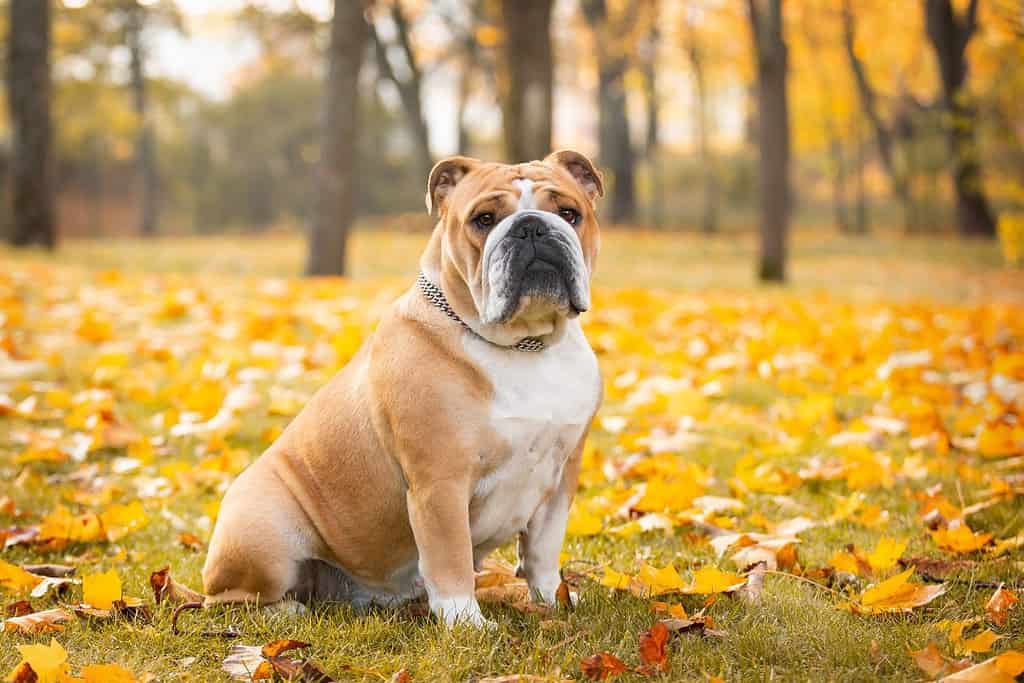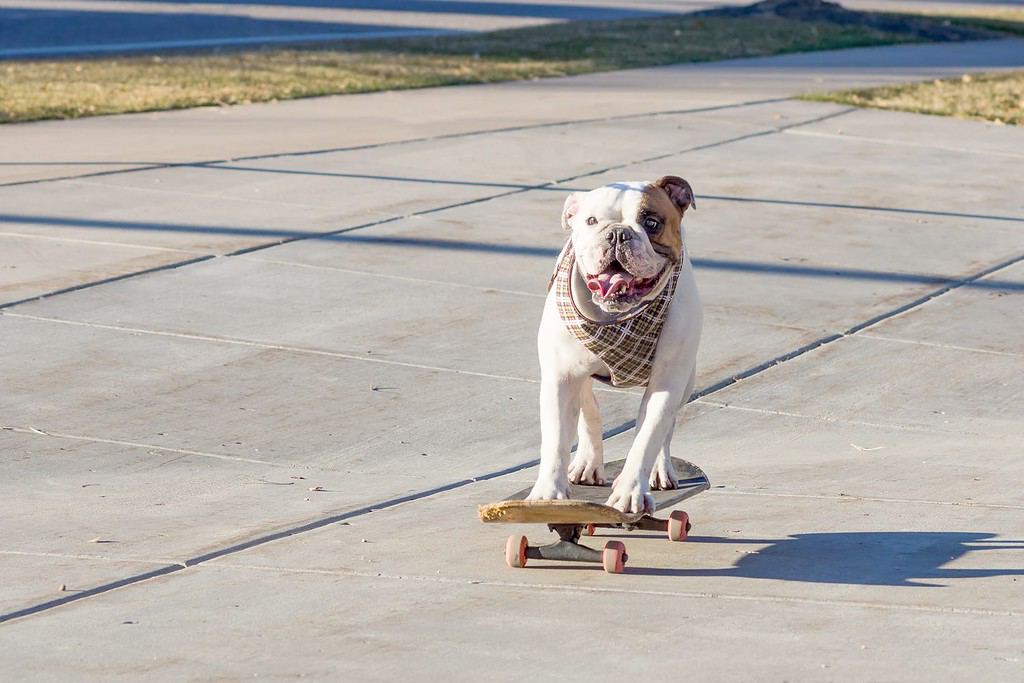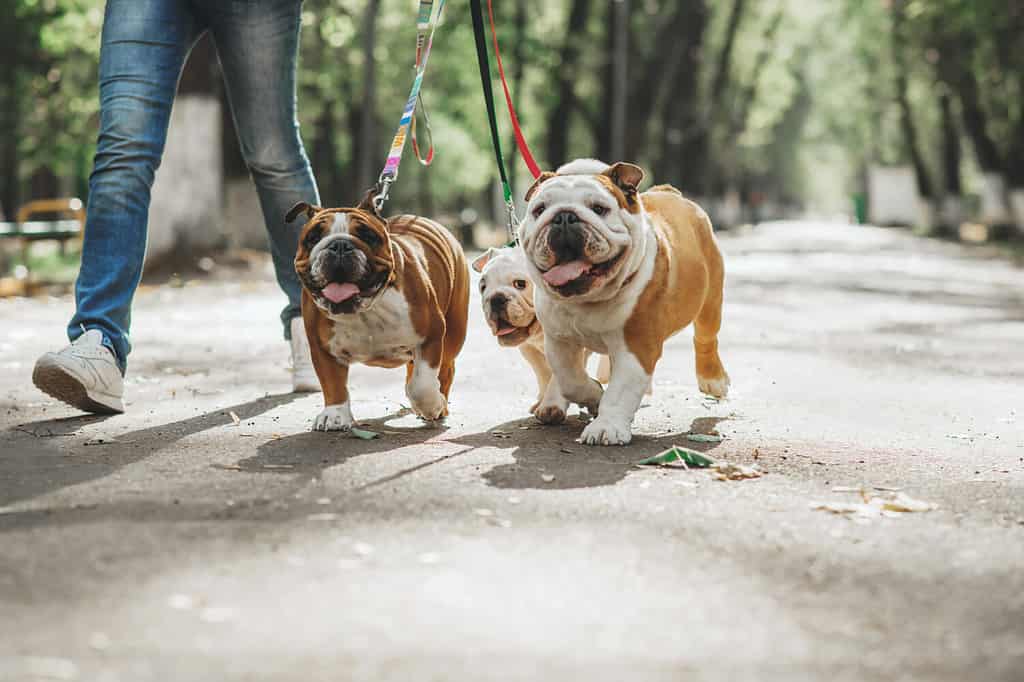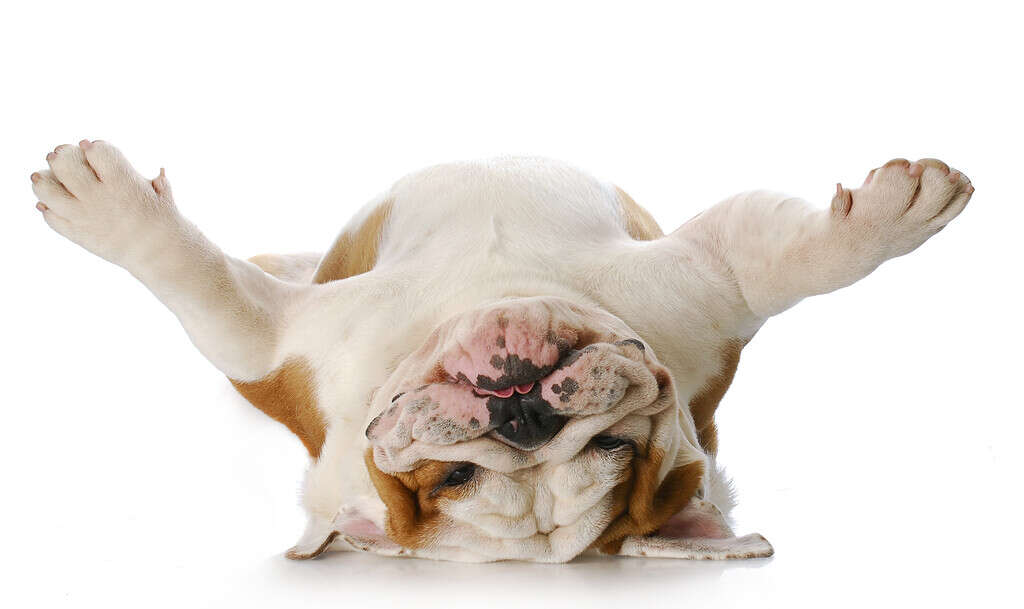In addition to their squished faces and adorable layers of wrinkles, bulldogs make loyal and lovable furry family members. Moreover, they’re even considered the fifth most popular dog breed in America. But bulldogs are more than just a pretty face: they’re considered remarkably brainy when it comes to following their instincts. That means they make great watchdogs and are dedicated to guarding their families. However, these snorelords are not considered ‘traditionally’ intelligent when it comes to obedience training and can often be stubborn. So, how can new bulldog owners train their beloved new furry family members?
The ‘Skinny’ on Our Chonky Companions

Bulldogs are easygoing, friendly, and devoted dogs.
©Vera Reva/Shutterstock.com
Also known as English bulldogs, these stocky and social biscuit bulldozers grow to a height of 12-14 inches and range from 39 to 55 pounds. Known for their highly distinctive appearance, bulldogs’ light-to-moderately shedding coat comes in a variety of unique colors and patterns. Sadly, these delightful dogs have a short lifespan, typically living 8-10 years, but often show signs of aging as early as five or six. Bulldogs are predisposed to several health conditions, such as brachycephalic syndrome, skin infections, numerous eye problems, difficulty regulating their body temperatures, and obesity. The best way to give your furry friend a happy, healthy life is to provide regular mental enrichment, veterinary care, exercise, and a good diet.
Are Bulldogs Difficult to Train?

Bulldogs are eager to please but can have a stubborn streak.
©IrinaK/Shutterstock.com
According to the AKC, bulldogs are relatively eager to please. When our furry friends rate high in this area, that typically means they will thrive in training. However, a dash of stubbornness combined with being relatively slow to learn new things can make training these pups a lesson in patience. That being said, these devoted and affectionate dogs are still great options for first-time owners. When it comes to training, it’s important to remember:
- Start Training as Young as Possible – Begin with easy commands to introduce them slowly.
- Keep Training Sessions Short – Dogs can tire out quickly from challenging mental stimulation.
- Use Plenty of Rewards – Have a variety of tasty treats or their favorite toys on hand to reward good behavior.
- Try a Clicker or Mark Work – Having a distinctive sound to mark the desired behavior exactly as your pooch does it can help them learn more quickly. If you don’t feel coordinated enough to use a clicker, enthusiastically saying “Yes!” also marks the behavior.
- Build Trust – It’s crucial to have a solid foundation built on trust when training your dog. Things like not following through with rewards, harsh punishments, and not spending enough time with your dog can diminish trust.
Basic Bulldog Training

When training your bulldog, start with basics like “the name game.”
©Ann Tyurina/Shutterstock.com
When it comes to training your bulldog, it’s crucial to begin with small and easy skills. To get started, our stubborn, wrinkly friends require tons of patience and short training sessions. Provide plenty of positive reinforcement for desired behaviors, such as their favorite treats or toys. Additionally, it’s important to avoid harsh punishments that could diminish trust between you and your pet. When first training with your bulldog, whether a new puppy or a recently adopted adult, focus on the following starter commands first:
The Name Game
This is a crucial trust-building game that reinforces their name. This game is beneficial, whether it be the name they came with or a new one you’ve selected. Throughout the day, say the dog’s name, and reward them with lots of affection and treats when they turn to look at you. The desired behavior is that you want to have their full attention when you call their name.
Crate Training
A crate should not be considered a punishment for your bulldog. Instead, a crate should be a safe space for your canine companion. Dogs naturally seek out quiet, comfortable, and safe spaces to relax, and the crate should be just that. Start by creating a positive relationship between your dog and its crate. To do so, begin feeding your dog in its crate. Another great exercise is playing games where you toss toys in your dog’s kennel, and they must go in to retrieve them. When first confining your pup to its crate, start small with short periods and praise your pooch when it rests calmly.
House Training
When focusing on house training, make sure to take your biscuit bestie outside frequently throughout the day to avoid any accidents inside your house. Heavily praise your learning pup every time they relieve themselves outside so they learn that’s the appropriate place to go. Additionally, adding items into your routine, such as potty bells on the door handle, can encourage your bulldog to alert you when they need to go outside. To get started, when taking your dog outside, try to encourage them to sniff at the bell or paw at it in order to make a noise. Once an audible sound has been made, reward them and immediately take them outside. This will eventually lead to them ringing the bell to alert you that they want out.
Get Them Used to Human Touch
Grooming and veterinary care are paramount to any dog’s health, so it’s important to set a solid foundation early for your bulldog to prepare them for these types of scenarios. Start acclimating your pooch to being touched all over as early as possible. Make sure you start small by running your hands all over their body. Pick up each paw one at a time and feel between toes and paw pads. Look inside ears and even roll them onto their side and back to feel their stomachs. Additionally, try allowing friends or family members to do the same in order to encourage your pooch to become comfortable accepting this attention from a variety of people. Then, this won’t be such a shock during vet visits or grooming. Always be patient as your beloved bulldog learns what is expected of them, and give lots of rewards for positive behavior.
Socialize Your Dog as Early and as Much as Possible
The most important period of your dog’s cognitive development is from three to 14 weeks. During this time, it’s crucial to try to positively and safely introduce your pooch to as many new experiences as possible. Start with short trips out to dog-friendly stores or outdoor walking areas. If your puppy is not fully vaccinated yet, carry them and do not allow strangers to touch them. This is just letting your puppy take in their surroundings safely and calmly. Reward your new furry family member consistently to help your pup gain confidence. If any loud noises arise that cause concern for your pooch, offer calm reassurance, but do not build the situation up into a bigger ordeal.
Once your puppy is vaccinated and it’s safe to allow them to walk in areas other dogs may also travel, allow your pooch to explore their surroundings more. Every time they check in with you, reward them with lots of treats and praise. This is a great opportunity to play the name game again. Also, try to discourage your furry friend from becoming overly excited around other people or dogs, as this could lead to a high drive for social interaction and even reactivity in the future. During this developmental period, try to safely introduce your bulldog to as many walking surfaces, environments, and weird noises as possible.
Leash Training
Leash training is necessary for taking your new bulldog out for walks or visiting public places. Until your puppy is fully vaccinated, start practicing at home to keep them from being at risk of any illnesses that could be passed onto them from other dogs. Begin training with a relatively shorter leash so you don’t have much extra to hold in your hand. Suppose you intend to eventually become more involved in advanced obedience training and even competitions one day. In that case, you’ll want to differentiate between a formal heel, which typically requires the dog’s attention, and a simple leisurely walk alongside you. Leash etiquette while out in public suggests you train your pup to walk closely beside you, traditionally on your left.
When you’re ready to venture out, start with less-populated places with fewer distractions in order to give your pup more opportunities to succeed. Reward them for walking alongside you and any time they voluntarily give you eye contact. Encouraging your pooch to sit calmly beside you anytime you stop is also very useful. Discourage your furry friend from rushing up to other people or dogs, and only allow them to accept pets from strangers (with your permission) when calmly sitting.
Common Bulldog Training Mistakes

Bulldogs require patience, consistency, and positive reinforcement while training.
©WilleeCole/iStock via Getty Images
Because bulldogs can be slow learners and stubborn, it’s imperative that you be patient and consistent with training. Firstly, try breaking training up into snack-sized sessions a couple times a day. A fun and easy trick is to do a few exercises before you give your pup their breakfast and dinner. At that point, you’ll most certainly have their attention. Also, they are more likely to respond to your commands because they’re ready to eat! Additionally, if your wrinkly wigglebutt has been training too long, it will no longer feel like they’re having fun. At that point, they’re less likely to cooperate and will instead shut down.
Lastly, the worst mistake you can make while training your bulldog is to take a reactive approach that relies solely on punishing bad behavior. Harsh corrections can make your dog leery of trusting you. If trust is habitually broken, your dog will be difficult to train, and your relationship will suffer. Instead, you should focus heavily on positively reinforcing good behavior.
Enjoying Life with Your Pawsome, Pudgy Pal

Bulldogs make great family pets when trained properly.
©Lakshmi3/iStock / Getty Images Plus via Getty Images
Known as both kind and courageous, bulldogs are endlessly devoted to their human companions. Despite being social butterflies, they still feel protective over their families and make sufficient watchdogs. With proper veterinary care, exercise, and training, these walking wrinkles can be the perfect example of man’s best friend. Enjoy every second with these silly and sweet pups!
The photo featured at the top of this post is © Serova_Ekaterina/Shutterstock.com
Ready to discover the top 10 cutest dog breeds in the entire world?
How about the fastest dogs, the largest dogs and those that are -- quite frankly -- just the kindest dogs on the planet? Each day, AZ Animals sends out lists just like this to our thousands of email subscribers. And the best part? It's FREE. Join today by entering your email below.
Thank you for reading! Have some feedback for us? Contact the AZ Animals editorial team.







